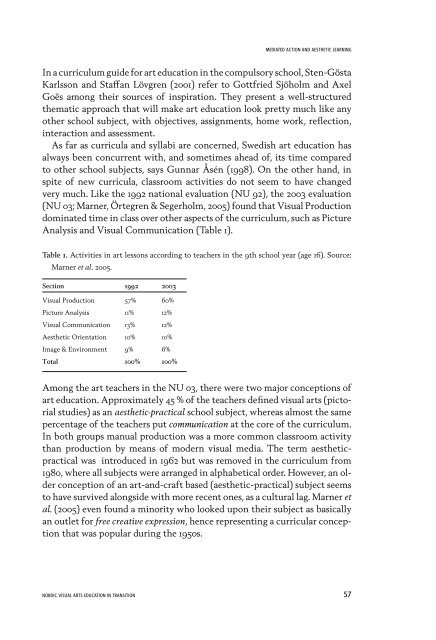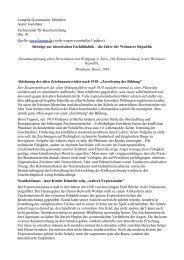Research in Visual Arts Education - The National Society for ...
Research in Visual Arts Education - The National Society for ...
Research in Visual Arts Education - The National Society for ...
Create successful ePaper yourself
Turn your PDF publications into a flip-book with our unique Google optimized e-Paper software.
MEDIATED ACTION AND AESTHETIC LEARNING<br />
In a curriculum guide <strong>for</strong> art education <strong>in</strong> the compulsory school, Sten-Gösta<br />
Karlsson and Staffan Lövgren (2001) refer to Gottfried Sjöholm and Axel<br />
Goës among their sources of <strong>in</strong>spiration. <strong>The</strong>y present a well-structured<br />
thematic approach that will make art education look pretty much like any<br />
other school subject, with objectives, assignments, home work, reflection,<br />
<strong>in</strong>teraction and assessment.<br />
As far as curricula and syllabi are concerned, Swedish art education has<br />
always been concurrent with, and sometimes ahead of, its time compared<br />
to other school subjects, says Gunnar Åsén (1998). On the other hand, <strong>in</strong><br />
spite of new curricula, classroom activities do not seem to have changed<br />
very much. Like the 1992 national evaluation (NU 92), the 2003 evaluation<br />
(NU 03; Marner, Örtegren & Segerholm, 2005) found that <strong>Visual</strong> Production<br />
dom<strong>in</strong>ated time <strong>in</strong> class over other aspects of the curriculum, such as Picture<br />
Analysis and <strong>Visual</strong> Communication (Table 1).<br />
Table 1. Activities <strong>in</strong> art lessons accord<strong>in</strong>g to teachers <strong>in</strong> the 9th school year (age 16). Source:<br />
Marner et al. 2005.<br />
Section 1992 2003<br />
<strong>Visual</strong> Production 57% 60%<br />
Picture Analysis 11% 12%<br />
<strong>Visual</strong> Communication 13% 12%<br />
Aesthetic Orientation 10% 10%<br />
Image & Environment 9% 6%<br />
Total 100% 100%<br />
Among the art teachers <strong>in</strong> the NU 03, there were two major conceptions of<br />
art education. Approximately 45 % of the teachers def<strong>in</strong>ed visual arts (pictorial<br />
studies) as an aesthetic-practical school subject, whereas almost the same<br />
percentage of the teachers put communication at the core of the curriculum.<br />
In both groups manual production was a more common classroom activity<br />
than production by means of modern visual media. <strong>The</strong> term aestheticpractical<br />
was <strong>in</strong>troduced <strong>in</strong> 1962 but was removed <strong>in</strong> the curriculum from<br />
1980, where all subjects were arranged <strong>in</strong> alphabetical order. However, an older<br />
conception of an art-and-craft based (aesthetic-practical) subject seems<br />
to have survived alongside with more recent ones, as a cultural lag. Marner et<br />
al. (2005) even found a m<strong>in</strong>ority who looked upon their subject as basically<br />
an outlet <strong>for</strong> free creative expression, hence represent<strong>in</strong>g a curricular conception<br />
that was popular dur<strong>in</strong>g the 1950s.<br />
NORDIC VISUAL ARTS EDUCATION IN TRANSITION 57



